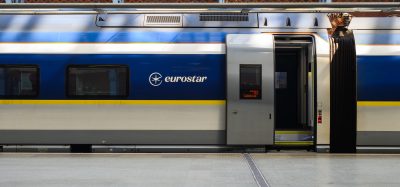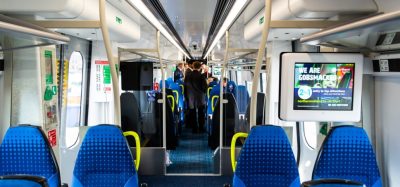The festival city of Salzburg gets a unique entrée
Posted: 4 August 2010 | | No comments yet
€270 million will be invested in the creation of a unique transport station in the festival city of Salzburg that is to be completed by 2014. The new through station will do full justice to the requirements of a modern railway age as a regional and international transport hub. High customer convenience, short distances, barrier-free changing of trains, optimal passenger information, a central passage with shopping facilities, a unique architectural concept integrating listed historic building elements into state-of-the-art railway infrastructure will give Salzburg a distinctive new entrée.
€270 million will be invested in the creation of a unique transport station in the festival city of Salzburg that is to be completed by 2014. The new through station will do full justice to the requirements of a modern railway age as a regional and international transport hub. High customer convenience, short distances, barrier-free changing of trains, optimal passenger information, a central passage with shopping facilities, a unique architectural concept integrating listed historic building elements into state-of-the-art railway infrastructure will give Salzburg a distinctive new entrée.
€270 million will be invested in the creation of a unique transport station in the festival city of Salzburg that is to be completed by 2014. The new through station will do full justice to the requirements of a modern railway age as a regional and international transport hub. High customer convenience, short distances, barrier-free changing of trains, optimal passenger information, a central passage with shopping facilities, a unique architectural concept integrating listed historic building elements into state-of-the-art railway infrastructure will give Salzburg a distinctive new entrée.
Combining historic building conservation with state-of-the-art railway architecture
The new railway station was designed in close cooperation with the Bundesdenkmalamt (Federal Office for Historic Building Conservation). Salzburg Central Station will become one of Austria’s most modern railway stations, with the historic monument remaining intact.
Part of the main building dates back to the year 1860 and is therefore exactly 150 years old. On 12 August 1860, the ‘Kaiserin Elisabeth Bahn’ (‘Empress Elizabeth’s Railway’) from Vienna to Salzburg was opened at the same time as Salzburg Central Station and linked with the Bavarian railway connection Salzburg–Munich, the so-called ‘Bayerische Maximilianbahn’ (‘Bavarian Maximilian’s Railway’). The connection from Salzburg to Trieste – a direct connection via the Hohe Tauern to the Mediterranean port of the Habsburg monarchy – started operation in the year 1909. At that time, the railway station was expanded with the track systems of the Tauern Railway Line and a centre island, vaulted by a steel frame hall. Both historic building elements characteristic for the railway station of Salzburg – the main building and the iron frame hall – will be an integral part of the new architectural overall concept. The iron frame hall will be refurbished and integrated into the modern transparent roofscape over the platforms as a central historic element.
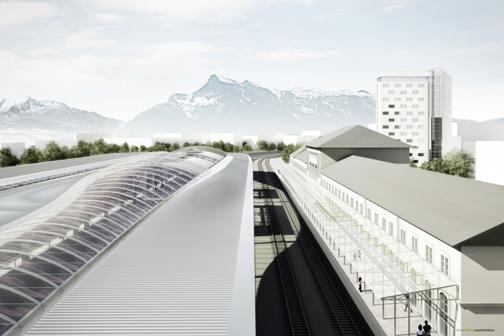

The new Salzburg Hauptbahnhof will be the inviting gate to the Alps
Gate to the Alps and new transport hub with regular-interval timetable
The historic track configuration of the railway station with the many ‘dead-end’ tracks ending in the central platform is typical for border stations like Salzburg Central Station. This track layout sometimes requires walking very long distances when changing trains, however, this no longer meets the current requirements of modern, European cross-border railway transport services.
The new Central Station, as a through station, will do full justice to the requirements of a modern, regional and pan-regional rail service market. With four new platform islands and a total of nine platforms, Salzburg will become an important railway transport hub with a regular-interval timetable for Austrian and European rail services and the second most important railway transport hub with a regular-interval timetable after Vienna Central Station which is presently under construction.
The new transport hub with a regularinterval timetable will be consistently expanded in the coming years. In Salzburg, long distance trains from several directions will coincide in the future (trains from and to Budapest / Vienna, Munich, Zurich / Innsbruck, Klagenfurt, Graz). This will open up ideal transfer connections in all directions with short stopover times. The regular-interval timetable of the suburban railway and the regional connections will also be linked with this regular-interval timetable.
Highest customer convenience
The bright, well-arranged railway station will ensure highest customer convenience for ÖBB’s passengers with short walking distances and good accessibility of the platforms via escalators, lifts and stairs. Shops and a customer centre with open design will be housed in the generous central passage. The entire railway station will be barrier-free and have a guide system for the blind.
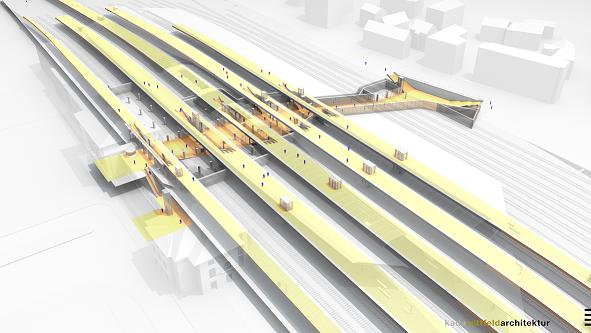

The new railway station passage not only optimally connects the platforms but also creates a new connection between the two districts Schallmoos and Elisabeth-Vorstadt. Copyright: ÖBB / kadawittfeldarchitektur
Concourse returned to the way it was in 1908/09
Also, the concourse of the Central Station was examined by archaeologists in the course of the refurbishment. During excavation works, they discovered well preserved gypsum structures on the walls and Art Nouveau paintings burnt in bricks. The Art Nouveau paintings from 1908/09, some of which were very well preserved, were protected and covered during construction works. Some damaged or missing parts of the paintings will have to be restored or reconstructed by experts. The paintings show impressive regional landscapes and landmarks from the region of Salzburg. With the railway came tourism. The tiles are a testimony of the good marketing skills already employed at the beginning of the past century. Today’s tourists are still attracted by similar motives: one of Austria’s best-known landmarks, the 3,798m-high Großglockner, as well as the image of the 3,662m-high Großvenediger Mountain used to and will be again on prominent display in Salzburg Central Station. The city of Salzburg presented itself at the railway station with the fortress Hohensalzburg, the famous castle gardens of Mirabell and the Hellbrunn Palace. Passengers will be greeted by the images of the picturesque Zell Lake and of the impressive buildings next to the waterfall of the Alpine health resort community of Bad Gastein. By the way, Bad Gastein’s touristic boom started when the Tauern Railway Line was put into operation in the year 1905 (or 1909 up to Trieste).
New connection between districts
The new railway station passage not only optimally connects the platforms, but also creates a new connection between the two districts Schallmoos and Elisabeth-Vorstadt. Thus the railway station gets an additional entrance from the district Schallmoos.
Stimulus for the modernisation of an entire district
The refurbishment of the Central Station will give a positive urban development stimulus to the entire environs. Together with the construction of the track systems, also the railway bridges across Plainstraße, Rainerstraße and the Nellböckviadukt will be newly constructed. Motorists, pedestrians and cyclists will immensely benefit from the modernisation. In Rainerstraße, additional space will be gained thanks to the construction works, on which a real estate project can be realised. Also in the area Weiserstraße/ Lastenstraße, there are attractive areas that can be used for urban development projects.
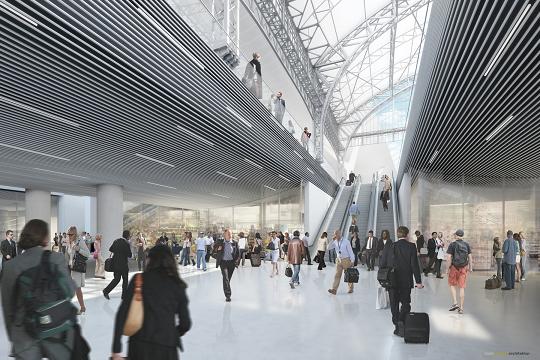

A light passage will connect two districts. The tracks are situated a level higher. Copyright: ÖBB / kadawittfeldarchitektur
Campaign for modern railway stations
With the new development of railway stations, ÖBB-Holding AG pursues several objectives. The railway stations are the gate to the railway system. A modern, convenient, bright, architecturally attractive face and additional facilities such as shops and travel information centres in this gate will ensure benefits to the entire railway system. Furthermore, the attractiveness of the overall urban appearance of all railway station districts – some of which had a controversial image in the past decades – will be boosted. New railway stations trigger urban development stimuli. The perking up of the entire district, in turn, increases the interest of investors in railway properties that ÖBB no longer requires for its operation. The proceeds of the sale of unused properties cover part of the required infrastructure investments in the railway. Real properties are developed as soon as the railway station has already been refurbished as core component and emanates positive vibes. The major railway stations Linz, Innsbruck and Graz have already been modernised in the past years. Currently, three other major projects of central importance to ÖBB are being realised with Vienna Central Station, Vienna West Station and Salzburg.
‘Explosive’ history
Like many other railway stations and track systems, Salzburg Central Station was a part of the important infrastructure facilities of the Third Reich and thus a strategic target for bombings from the Allied forces towards the end of the Second World War. During the war, 90% of the station was destroyed. After the war, it was rebuilt with the funds available at that time. Complicated and partly confusing accesses and a patchwork of installations added over the years thus created an overall impression that no longer met the contemporary requirements of the 25,000 daily passengers using the railway station. The necessary modernisation was discussed over a long period, but repeatedly postponed due to the high investment needs. With the integration of Europe, the abolition of state borders, the end of the serviceable life of the entire track/point systems combined with the longstanding wish of the customers for more comfort, less confusion and better accessibility of the track systems as well as the demand for a more attractive appearance, the time had come for modernisation.
However, the excavation of the building pits in the course of today’s refurbishment works still brings to light the dark European history chapter of the Second World War more than 65 years after its end. Since 2002, there is an active search for war relics in the general area of the railway station. Thousands of ground borings were made to carry out ferromagnetic measurements. Suspected bomb sites marked in historical maps were controlled. In the zones, in which bombings have taken place, a search for munitions was made for safety reasons also without any indication of suspected presence before every construction measure involving underground works such as the driving in of sheet piles, the boring of foundation piles or the installation of overhead line masts. To this day, the probing and excavation of war relics has cost more than €1 million. Among other things, it was possible to deactivate three 500 lbs aircraft bombs.
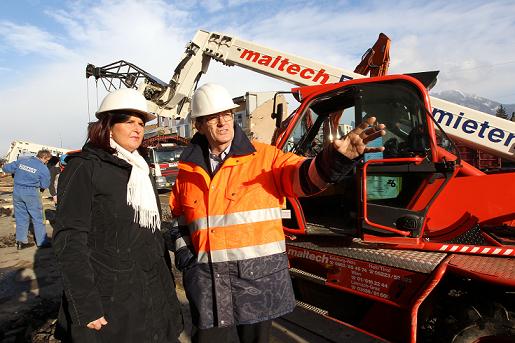

Project Manager Thomas Wörndl showing Gabi Burgstaller, Governer of Salzburg, the construction site. Copyright: ÖBB / Gfrerer
Innovative geothermal energy system for the railway station
Sustainability is an integral part of the ÖBB Group’s corporate strategy. With a new geothermal energy system for the major project in Salzburg, ÖBB puts an emphasis on active climate and environmental protection. The majority of heating and cooling energy will come from a geothermal system. With this step towards renewable energy, ÖBB further strengthens its leading position as an environmentally friendly mobility provider. Heat absorbers are integrated in 440 bored piles with a total pile length of 6,600m that ensure a stable foundation of the railway station in the unstable subsoil of Salzburg. In addition, 22 geothermal probes are bored up to 130m-deep. All in all, heat absorbers with an overall depth of 8,800m are bored or driven into the ground.
Thus, 80% of the cooling and 55% of the heating energy of the new Central Station are covered with renewable geothermal energy. The realisation of the system will save 1015 megawatt hours (MWh) of district heat and 314 MWh of electricity a year. This results in 286 tonnes of CO2 emissions avoided annually.
Climate protection that also saves money
The new geothermal energy system is a reasonable solution not only from an ecological outlook, but also from an economic point of view. The system will be amortised after seven years and will then save more than €100,000 on an annual basis.
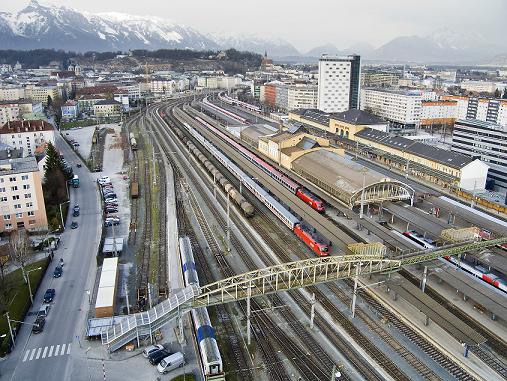

The middle platform used to be the barrier for international trains. The historic situation of Salzburg, being a frontier post between Austria and Germany, has changes with the integration of the European Union. Copyright: ÖBB
Challenge: construction under the ‘rolling wheel’
Like with any other modernisation projects of railway facilities, the ongoing railway operation plays a challenging role in the planning and implementation. A new shopping centre can be constructed on greenfield land. When a motorway node is built, the traffic is not led directly through the construction site, but deviated. On the other hand, when a railway node is modernised, operation must go on. It is not possible to redirect the trains. This also means that 25,000 daily passengers must be guided through the construction site at the railway station. Currently, only three platforms are fully available for continuous train operation in Salzburg. After completion in the year 2014, there will be three times as many. At the last timetable change in December 2009, important transit tracks were blocked, which then gave way to the excavation pit. Early on Monday morning following transition, many a railway manager’s pair of eyes was glued to the display panels and the digital operating data. Would the construction-site related delays in the sensitive railway node of Salzburg rock the entire structure of ÖBB’s timetable? Before the timetable change, scenarios had been calculated and simulated for months. The calculations yielded an exciting result: it was going to be that marginal that it was not possible to calculate with exactness whether the timetable would remain stable.
In practice, however, today’s timetable structure is largely stable and there are thousands of passengers every day who patiently put up with detours and short-term platform changes and are looking forward to the new Salzburg Central Station. Passengers, railway employees, tourists and managers all have one thing in common – the anticipation of the new Salzburg Central Station that will be the visiting card for the festival city and the gate for Europe to the beautiful Alps.
About the Authors
Johannes Gfrerer
Mag. Johannes Gfrerer studied journalism, communication science and political science at University of Vienna and has had jobs on ‘both sides’ of the media business – as a journalist and as a communication manager. Since 2000, he has been the ÖBB-Spokesman for the Austrian federal state of Salzburg. He is also responsible for the regional communication activities of all companies of the ÖBB group.
Thomas Wörndl
DI Thomas Wörndl studied con – struction engineering at the University of Innsbruck. Since 1981 he has been active in the infrastructure division of the ÖBB. Since 1990, he has been Project Manager for new development of rail infrastructure. Today, he is in charge of the ‘S-Bahn Salzburg’, an implementation project of a new rack system and stations for urban-regional traffic, and also the Project Manager for the reconstruction of the Salzburg Hauptbahnhof.




